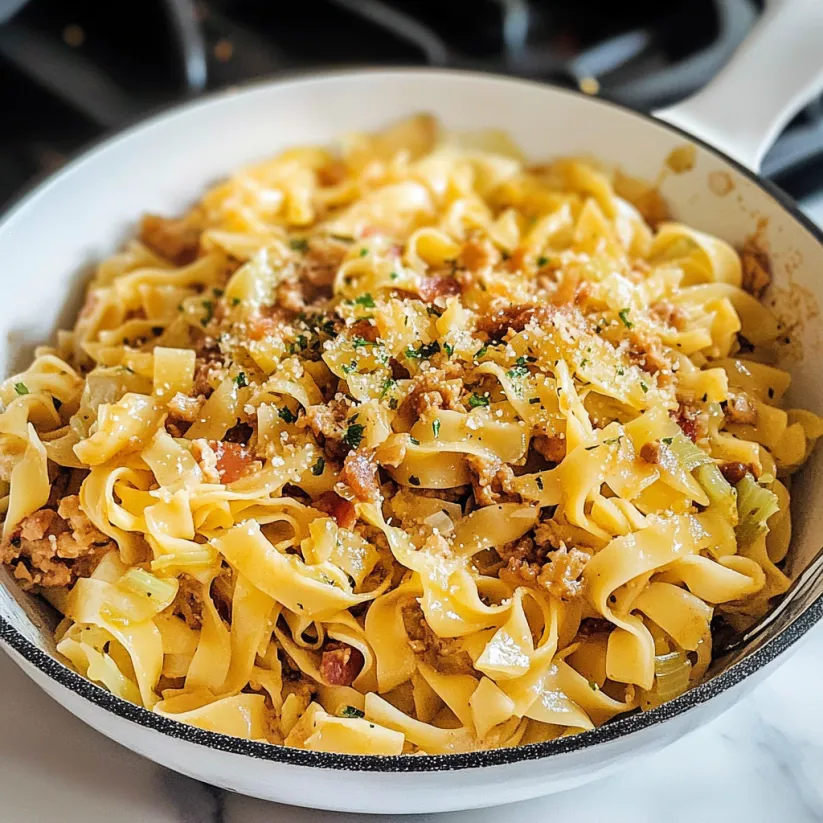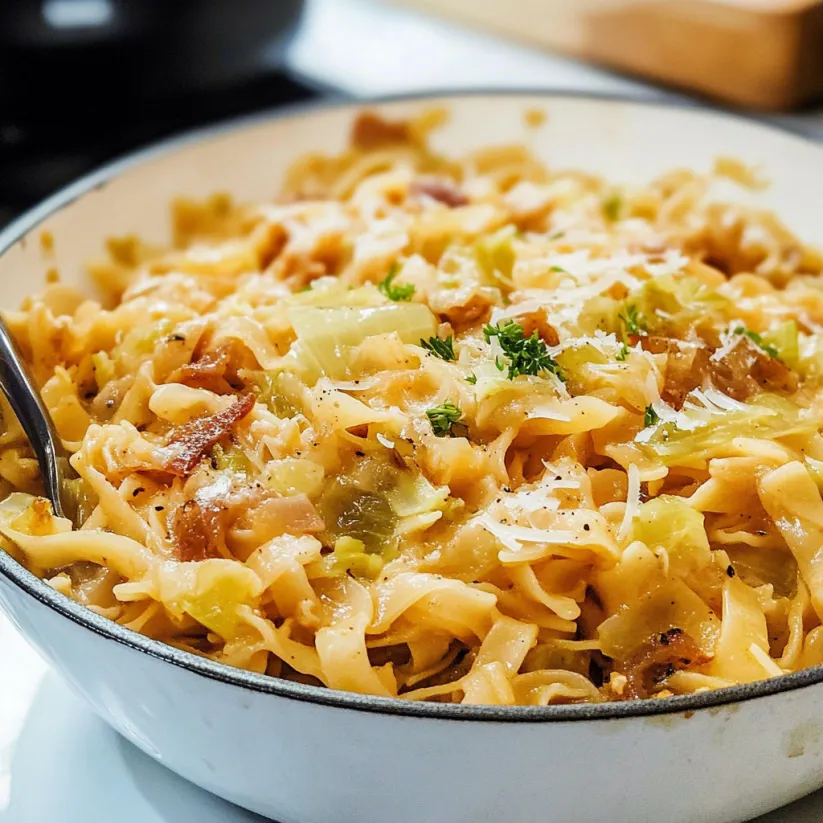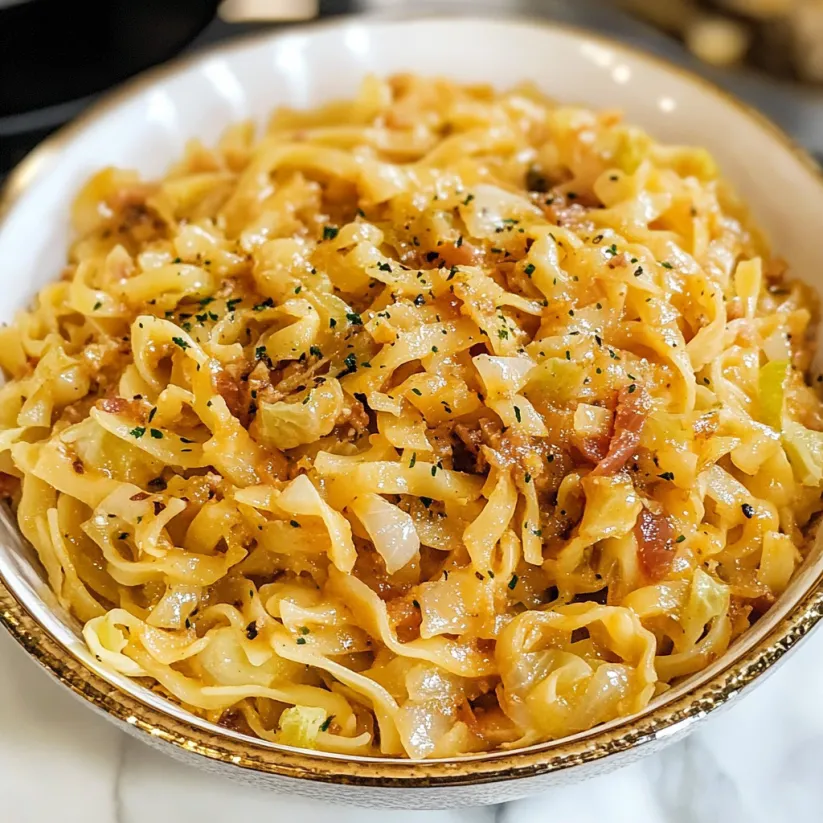 Save Pin
Save Pin
This hearty Haluski has been my comfort food go-to for years. The simple combination of cabbage, bacon, and egg noodles creates a dish that's greater than the sum of its parts—a true Eastern European treasure that satisfies deep cravings on cold evenings.
I first discovered Haluski during a winter when I was craving something comforting but different from my usual pasta dishes. The first time I served it to my family, there was complete silence at the dinner table—the kind that only happens when everyone is too busy enjoying their food to talk.
Ingredients
- Thick cut bacon Provides the savory foundation and renders fat that flavors the entire dish. Look for quality bacon with visible meat not just fat.
- Unsalted butter Creates richness and allows you to control salt levels. European style butter works beautifully here.
- Large onions Sweet onions like Vidalia work wonderfully as they caramelize and add natural sweetness. Choose firm onions without soft spots.
- Green cabbage The star ingredient that becomes silky when cooked properly. Select a tight, heavy head that feels dense for its size.
- Salt and pepper Simple seasonings that let the ingredients shine. Freshly ground black pepper makes a noticeable difference.
- Egg noodles Medium wide egg noodles hold up well to the other ingredients. Look for noodles with a slightly rough texture that will grip the butter.
Step-by-Step Instructions
- Cook the Bacon
- Start with a cold Dutch oven and add the chopped bacon. Cook over medium heat until the fat renders and the bacon is almost crisp but not burnt. This should take about 5 to 7 minutes. The bacon fat creates the flavor foundation for the entire dish.
- Sauté the Onions
- Add 3 tablespoons of butter to the bacon and rendered fat. Once melted add the chopped onions and sauté for a full 5 minutes. Be patient here as properly softened onions will melt into the dish creating a sweet background note. They should become translucent and slightly golden.
- Cook the Cabbage
- Add the cabbage pieces to the pot along with salt and pepper. Stir everything thoroughly to coat the cabbage in the fats. Cover and cook for 10 minutes, stirring occasionally. The cabbage should soften but maintain some texture. If it seems too dry add a tablespoon of water.
- Prepare the Noodles
- While the cabbage cooks bring a large pot of salted water to a rolling boil. Cook the egg noodles according to package directions until al dente. Be careful not to overcook as they will continue cooking slightly when added to the cabbage mixture.
- Combine Everything
- Add the drained noodles to the Dutch oven with the cabbage mixture. Add the remaining 3 tablespoons of butter and gently toss everything together. Let it cook for 2 to 3 more minutes so the noodles can absorb the flavors and the butter can coat everything.
- Final Seasoning
- Taste the dish and adjust the seasoning with additional salt and pepper as needed. The flavors should be balanced with the richness of butter, smokiness of bacon and sweetness of cabbage and onions all coming through.
 Save Pin
Save Pin
My grandmother taught me to always cook the cabbage until just tender but never mushy. She would taste a piece of cabbage before adding the noodles saying "when the cabbage sings with butter it's ready." That memory always makes me smile when I prepare this dish for my own family.
Historical Background
Haluski traces its roots to Eastern European countries including Poland, Slovakia, and Ukraine. Traditionally, it was a peasant dish made to stretch ingredients and fill hungry bellies during cold winters. The dish varies by region some versions include cottage cheese or sour cream while others focus on the simple combination of cabbage and noodles. What remains consistent is the comfort it provides and how it showcases the beauty of transforming humble ingredients into something special.
Ingredient Substitutions
While traditional Haluski relies on classic ingredients, modern dietary needs sometimes require adaptations. For a vegetarian version, omit the bacon and use 2 additional tablespoons of butter with 1 teaspoon of smoked paprika to mimic that smoky flavor. Those avoiding gluten can substitute rice noodles or gluten free pasta though the texture will differ slightly. If green cabbage isn't available savoy cabbage makes an excellent substitute with its delicate texture and sweet flavor profile.
Serving Suggestions
Haluski works beautifully alongside roasted meats particularly pork tenderloin or roast chicken. For a complete meal serve with a tangy cucumber salad to cut through the richness. A dollop of sour cream on top adds creamy indulgence while fresh herbs like dill or parsley brighten the dish. In Polish households it's common to serve Haluski as a hearty side dish during Easter celebrations alongside kielbasa and pierogies creating a feast of beloved traditions.
Storage Tips
Haluski keeps remarkably well in the refrigerator for up to 4 days stored in an airtight container. The flavors actually improve overnight as they meld together. When reheating add a small splash of water and a pat of butter to refresh the dish. Warm it gently on the stovetop rather than microwaving for best texture. While you can freeze Haluski the texture of the cabbage and noodles will change slightly upon thawing but the flavor remains delicious.
 Save Pin
Save Pin
Commonly Asked Questions
- → What is traditional Haluski?
Traditional Haluski is an Eastern European dish (popular in Polish and Slovakian cuisines) consisting of cabbage and egg noodles cooked with bacon and butter. The simple ingredients create a hearty, comforting meal where the cabbage is sautéed until tender but still retains some texture, then combined with cooked egg noodles and seasoned primarily with salt and pepper.
- → Can I make Haluski vegetarian?
Yes, Haluski can easily be made vegetarian by omitting the bacon or substituting it with a smoky meat alternative. Simply increase the butter for additional flavor or use a vegetable-based butter substitute. The dish will still maintain its characteristic comfort food appeal with the cabbage and noodle base.
- → What type of noodles work best for Haluski?
Medium-wide egg noodles are traditional for Haluski, but you can substitute with fettuccine or tagliatelle if needed. The key is using a pasta substantial enough to hold up against the cabbage and bacon while absorbing the buttery flavors of the dish.
- → How should I store leftover Haluski?
Store leftover Haluski in an airtight container in the refrigerator for 3-4 days. Reheat gently on the stovetop with a splash of water or broth to restore moisture, or microwave until heated through. The flavors often deepen after a day, making leftovers particularly delicious.
- → What can I serve with Haluski?
Haluski works well as a main dish on its own but can also be served as a side dish alongside roasted meats, particularly pork. A simple green salad with a vinaigrette dressing makes a nice contrasting side. For a traditional Eastern European meal, consider serving with kielbasa or other smoked sausages.
- → Is Haluski difficult to make?
Haluski is quite simple to prepare, making it perfect for beginners or busy cooks. The techniques involved—cooking bacon, sautéing vegetables, and boiling noodles—are straightforward. The entire dish comes together in about 40 minutes with minimal preparation, requiring just one pot for the cabbage mixture and another for cooking the noodles.
